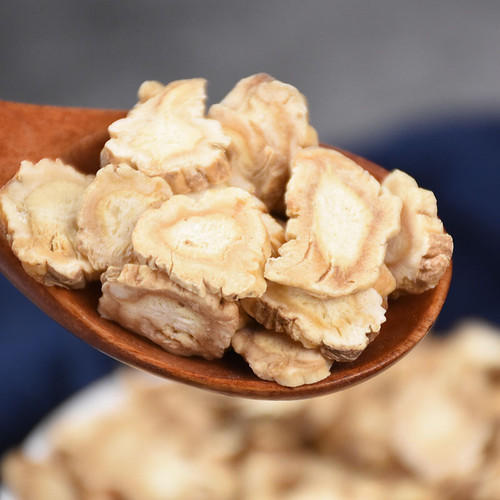Product Overview
Parts used: Dried rhizome node
TCM category: Herbs that stop bleeding
TCM nature: Neutral
TCM taste(s): Sour Sweet
Meridian affinity: Stomach Liver Lung
Scientific name: Nelumbo nucifera
Use of lotus roots (Ou Jie) in TCM
Please note that you should never self-prescribe TCM ingredients. A TCM ingredient is almost never eaten on its own but as part of a formula containing several ingredients that act together. Please consult a professional TCM practitionner, they will be best able to guide you.
Preparation: Remove impurities from the knots, wash and dry
Dosage: 6 - 12 grams
Main actions according to TCM*: Stops bleeding and reduces swelling due to Heat in the Blood.
Primary conditions or symptoms for which lotus roots may be prescribed by TCM doctors*: Nosebleed Hematochezia Bloody sputum Hematemesis Hematuria
Common TCM formulas in which lotus roots are used*:
For abnormal uterine bleeding combine lotus roots with dong quai (Dang Gui) and motherwort herbs (Yi Mu Cao).
For Heat-induced nosebleeds, hematuria and/or blood-tinged sputum combine lotus roots with cogongrass rhizomes (Bai Mao Gen) and unprepared rehmannia (Di Huang).
Key TCM concepts behind lotus roots (Ou Jie)'s properties
In Traditional Chinese Medicine (TCM), lotus roots are plants that belong to the 'Herbs that stop bleeding' category. Like the name indicates these herbs tend to have hemostatic properties, meaning that they help stop various types of hemorrhages and echymosis. Unlike other herbs they often tend to be used externally.
Furthermore lotus roots are plants that are Neutral in nature. This means that lotus roots typically don't affect the balance in your body. Balance between Yin and Yang is a key health concept in TCM. Eating too many "Hot" (Yang) ingredients can lead to an imbalance whereby one has a Yang excess. The inverse is true as well: too many "Cold" (Yin) ingredients can lead to a Yin excess. The Neutral nature of lotus roots means that you don't have to worry about that!
Lotus roots also taste Sour and Sweet. The so-called "five elements" theory in Chinese Medicine states that the taste of TCM ingredients is a key determinant of their action in the body. Sour ingredients like lotus roots help with digestion and restrain abnormal discharges of fluids from the body, such as diarrhea or heavy sweating. On the other hand Sweet ingredients tend to slow down acute reactions and detoxify the body. They also have a tonic effect because they replenish Qi and Blood.
The tastes of ingredients in TCM also determine what organs and meridians they target. As such lotus roots are thought to target the Stomach, the Liver and the Lung. In TCM the Stomach is responsible for receiving and ripening ingested food and fluids. It is also tasked with descending the digested elements downwards to the Small Intestine. The Liver on the other hand is often referred as the body's "general" because it is in charge of regulating the movements of Qi and body fluids. It also takes a leading role in balancing our emotions. In addition to performing respiration, the Lungs are thought to be a key part of the production chain for Qi and the body fluids that nourish the body.
Use of lotus roots (Ou Jie) as food
Lotus roots are also eaten as food. It is used as an ingredient in dishes such as Stir-Fried Lotus Root or Kung Pao Lotus Root.







